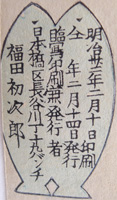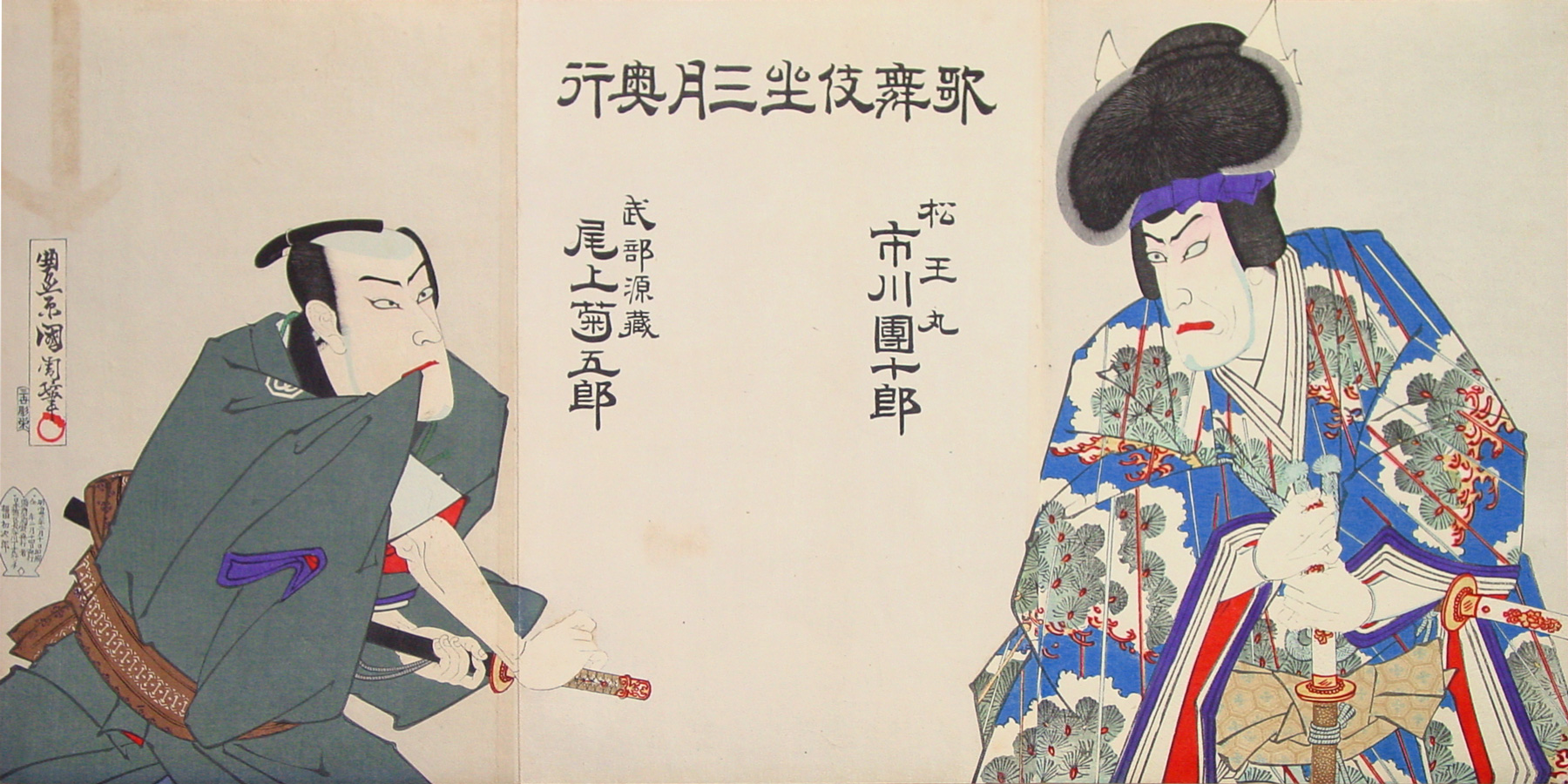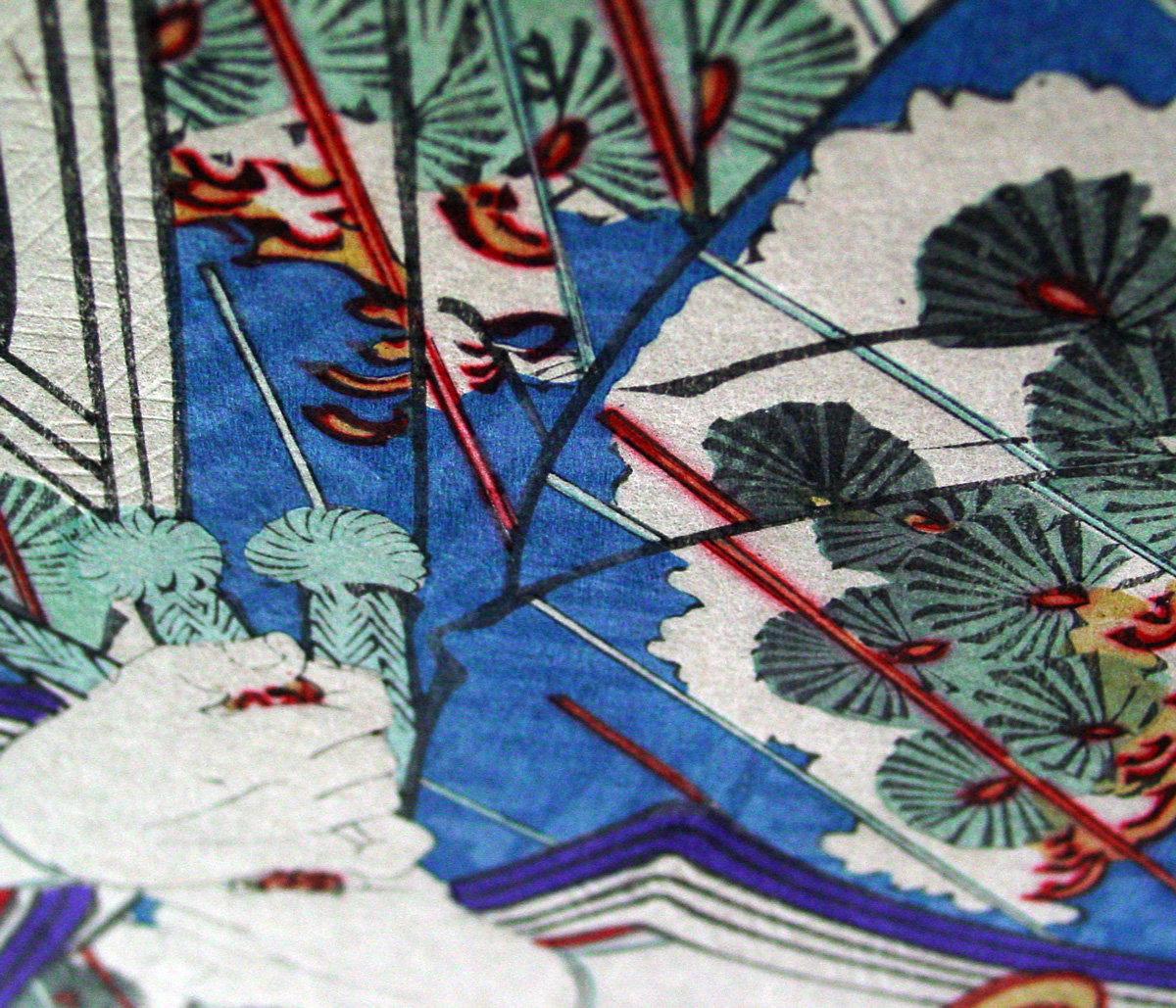About This Print
Source: With thanks to Guy Pepermans and the Ukiyo-e Q & A bulletin board at http://www.ukiyo-e.se/wwwboard/wwwboard.htmlPicturing the actors Onoe Kikugoro V as Takebe Genzo and Ichikawa Danjuro IX as Matsuomaru, this print is an announcement for the play Sugawara denju tenarai kagami (Sugawara and the Secrets of Calligraphy) staged in Tokyo's Kabukiza theater1 in March 1899.
1 The Kabukiza opened on November 21, 1889 and remains in operation today.
Detail showing subtle pattern of Danjuro's robe
The Actors Pictured
For background on the actors Ichikawa Danjuro IX (1838-1903) and Onoe Kikugoro V (1844-1903) see their respective entries in the article The Kabuki Actor on this site.The Play Sugawara Denju Tenarai Kagami
Sources: Website of the University of Virginia Library Japanese Text Initiative http://etext.virginia.edu/japanese/kabuki/sugawara/kennelly-sugawara.html and Kabuki 21 website http://www.kabuki21.com/sdtk.phpSugawara Denju Tenarai Kagami (Sugawara and the Secrets of Calligraphy), originally a jôruri (puppet) play in five acts in the jidamono (history play) style, was written by Takeda Izumo II, Miyoshi Shôraku, and Namiki Sôsuke in 1746 and quickly adapted into kabuki. While the play drew on one by Chikamatsu Monzaemon (1653-1725), Tenjin-ki (Chronicle of Tenjin), the playwrights added various folktale elements and plot innovations.
The play is based on the life of Sugawara no Michizane (845~903), a renowned scholar who was promoted to the prestigious rank of "Right Minister," one of the 2 close advisers of the Emperor. Falsely accused by Fujiwara no Shihei, the "Left Minister", of trying to hatch a plot with Prince Tokiyo to seize power, Sugawara no Michizane was exiled to Kyûshû. He dedicated his last years in writing poems, expressing both his homesickness and his innocence. After his death, the Emperor's residence was often struck by lightning and people thought it was done by the vengeful spirit of Sugawara no Michizane. A shrine was built in Kyôto to appease the spirit, the Kitano Tenmangû, and Sugawara no Michizane was revered as a god (Tenjin) and patron of calligraphy and scholarship.1 In the play Sugawara no Michizane is called Kan Shôjô.
A number of characters were added for purposes of the play including the triplets, Matsuômaru, Umeômaru, and Sakuramaru along with Takebe Genzô and his wife, and Michizane’s aunt Kakuju. The triplets are the sons of Sugawara's retainer, Shiratayû. When they were born, Sugawara stood sponsor to all three and named them after the trees he loved best, Matsu (Pine), Ume (Plum) and Sakura (Cherry). On their father's retirement, Umeômaru took his place as Sugawara's personal retainer. At the same time his two others brothers were found equally worthy employment, one as the retainer of Prince Tokiyo and the other in the household of Sugawara's colleague, Fujiwara no Shihei. When Shihei's jealousy brought about Sugawara's downfall, the triplets became the victims of divided loyalties.
1 In modern Japan with students praying at the numerous Tenjin shrines for success in entrance examinations at all levels of the education system.
Print Details
| IHL Catalog | #404 |
| Title (Description) | Kabukiza sangatsu okuyuki 行奥月三座伎舞歌 (Nearby entries in March at the Kabuki theatre). The actors Onoe Kikugoro V in the role of Takebe Genzo and Ichikawa Danjuro IX in the role of Matsuomaru in the play Sugawara denju tenarai kagami. |
| Artist | Toyohara Kunichika (1835–1900) |
| Signature | Toyohara Kunichika hitsu |
| Seal | Red Toshidama seal below signature |
| Publication Date | February 1899 (Meiji 32) |
| Publisher |  [Marks: publisher ref. 070; similar to seal 30-062] |
| Carver |  |
| Impression | excellent |
| Colors | excellent |
| Condition | good- minor margin trimming; backed with three sheets joined; offsetting in upper left corner of left panel and minor soiling |
| Genre | ukiyo-e; nigao-e; yakusha-e |
| Miscellaneous | |
| Format | vertical oban triptych |
| H x W Paper | 13 3/4 x 27 3/4 in. (34.9 x 70.5 cm) |
| Literature | |
| Collections This Print |



